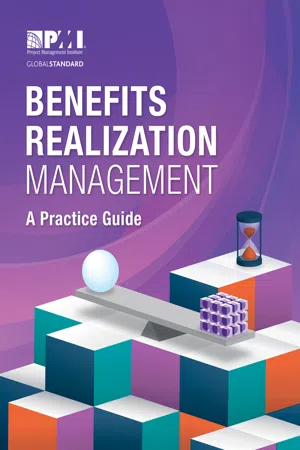
- 94 pages
- English
- ePUB (mobile friendly)
- Available on iOS & Android
About This Book
Benefits realization is the common thread that runs from organizational strategy through project deliverables that contribute benefits. Yet, according to PMI's 2018 Pulse of the Profession Report: Success in Disruptive Times, only one in three organizations report high benefits realization maturity. This practice guide provides a comprehensive look at the topic of benefits realization in of portfolio, program, and project management. It will help readers tackle this important topic and drive more successful outcomes and better strategic alignment in your organization. Inside this practice guide readers will find: standardized definitions for benefits realization, benefits realization management and associated benefits realization terms; the core principles of benefits realization; the benefits realization management life cycle from organizational mission, vision, and strategy through project deliverables and success measurement, and how it contributes to the expected benefits and value that the organization intends to realize; and a framework and guidance to help practitioners manage benefits realization in organizational project management and portfolio, program, and project management. As with all PMI standards and publications, this practice guide also aligns with our other standards including: A Guide to the Project Management Body of Knowledge (PMBOK Guide)®—Sixth Edition; The Standard for Program Management—Fourth Edition; and The Standard for Portfolio Management—Fourth Edition.
Frequently asked questions
Information
1
INTRODUCTION
- Provides a practical description of what BRM is;
- Defines the role and life cycle relationships of BRM to portfolios, programs, and projects;
- Describes why BRM is important;
- Identifies the key principles and critical success enablers needed to help an organization achieve the realization of planned benefits they seek as part of its strategic vision;
- Provides general guidance for organizations in establishing their approach to BRM in the context of portfolios, programs, projects, and organizational change management; and
- Identifies a common vocabulary to aid in the discussion of BRM.
- Understand the fundamentals of BRM,
- Consider how to adapt and adjust existing techniques and practices to meet organizational needs, and,
- Support BRM in areas of practice where there may not yet be consensus as to how BRM should be used or changed for the better.
- Fewer than 1 in 10 organizations report having a very high maturity with their value delivery capabilities.
- The average percentage of projects that met original goals/business intent was 78% for mature organizations and 56% for immature organizations.
- Only 31% of organizations are prioritizing the development of a comprehensive value delivery capability.
- Of the champion companies, those making the investment to have high-delivery capabilities, 87% report having achieved high-delivery capabilities versus only 5% for underperformers.
- Managing portfolios of programs and projects based on planned strategic outcomes and benefits—and, specifically, value creation for the organization;
- Recognizing the extent of organizational change required if planned benefits are to be realized;
- Creating an environment for regular dialogue to secure alignment, assess progress, and course-correct, as needed, right from the start of each initiative among:
- Highest-level executives,
- Organization owners,
- Senior end users, and
- Appropriate portfolio, program, and project managers; and
- Establishing the right conditions for success, including:
- Setting expectations regarding the key principles of BRM,
- Establishing the supporting behaviors for those principles,
- Fostering a value-oriented environment, and
- Having the right portfolio, program, and project managers in place, along with senior-level leadership committed to doing BRM well.
- Identifying and achieving benefits expected from investments in portfolios, programs, and projects;
- Communicating benefits-related issues with executives and/or sponsors;
- Ensuring planned benefits stay aligned with and contribute to an organization's strategic goals and objectives; and
- Ensuring benefits that accrue from the outputs of portfolios, programs, and projects are realized and sustained.
- Benefit owners,
- Senior end users,
- Executive management team,
- Executive sponsors,
- Portfolio and program management office (PMO) managers,
- Functional/operations managers,
- Organizational change managers,
- Business analysts, and
- Portfolio, program, and project managers and their respective team members.
- Section 1 Introduction. This section includes an overview of the purpose and need for publishing PMI's first practice guide on BRM. The rationale and intended audience for this guide are also defined.
- Section 2 BRM and Organizational Context. This section describes where BRM fits in the organization, how strategy relates to benefits, what the core principles and critical success enablers of BRM are, along with a summary of organizational BRM roles and responsibilities.
- Section 3 BRM Framework Overview. This section describes the Identify, Execute, and Sustain life-cycle stages and the supporting activities, practices, and common tools needed to provide a viable BRM system in conjunction with the organization's portfolios, program, and projects.
- Section 4 Guidance for Portfolio, Program, and Project Managers in a BRM Context. This section offers guidance to portfolio, program, and project managers, as well as business analysts, on what actions and practices support and enhance engagement of their respective domains with BRM life-cycle activities.
- Appendix X1 Contributors and Reviewers of Benefits Realization Management: A Practice Guide.
- Appendix X2 Benefits Realization Management Readiness Survey.
- Appendix X3 BRM Research Summary.
- Glossary. The glossary provides definitions of key BRM terms.
2
BRM AND ORGANIZATIONAL CONTEXT
Table of contents
- Cover Page
- Title Page
- Copyright Page
- Notice
- Table of Contents
- List of Tables and Figures
- Preface
- 1. Introduction
- 2. BRM and Organizational Context
- 3. BRM Framework
- 4. Guidance for Portfolio, Program, and Project Management in a BRM Context
- Appendix X1. Contributors and Reviewers of Benefits Realization Management: A Practice Guide
- Appendix X2. Benefits Realization Management Readiness Survey
- Appendix X3. BRM Research Summary
- References
- Bibliography
- Glossary